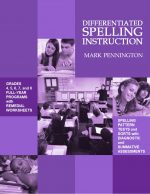High School Teaching Grammar and Mechanics
Teaching Grammar and Mechanics (new 2019 edition) helps high school teachers significantly improve student writing and test scores through direct instruction and individualized practice. This comprehensive curriculum is aligned with the Common Core Anchor Standards for Language and the Progressive Skills Review (alignment documents included). Preview Teaching Grammar and Mechanics High School
INSTRUCTIONAL COMPONENTS
Direct Instruction: This program provides a full year of 64 no-prep and minimal correction Cornell Note lessons. Teach two 30-minute lessons per week. The teacher lesson pages include teaching tips and online resources, such as those from the Purdue Online Writing Lab (OWL). These rigorous, yet easy-to-teach lessons (perfect for both the grammatically-challenged and expert grammarian) feature these resources:
- Interactive Instruction with Cornell Notes Read the lesson out loud and students copy the examples. Students have the full lesson text–no time-consuming copying–and may use comp books, spiral notebooks, or three-ring binders.
- Practice Sentences Students complete these independently and self-correct/edit from the display.
- Sentence Dictations Dictate brief formative assessments for each mechanics and grammar lesson focus. Students self-correct/edit from the display.
- Simple Sentence Diagrams Students self-correct/edit from the display.
- Mentor Texts with Writing Response Discuss how noted writers have used the grammatical component taught in the lesson. Students share their responses to the texts, including their own application of the grammar.
- 3D Graphic Organizer Students color, cut, and paste for review and writing application… as used in interactive notebooks. Walk the room and check the formative assessments, re-teach if necessary, and monitor student work.
Biweekly Tests: Administer these brief 20-minute tests after completing four lessons. The tests require students to define, identify, and apply the grammar,
usage, and mechanics content and skills with matching test items and sentence completions. Quick and easy to grade.
Diagnostic Grammar and Mechanics Assessments: Comprehensive whole-class diagnostic grammar, usage, and mechanics assessments provide the data to help teachers individualize instruction. A grammar and mechanics recording matrix makes assessment data entry simple and progress monitoring efficient.
Individualized Instruction: 77 targeted grammar, usage, and mechanics worksheets, corresponding to each skill tested in the diagnostic assessments. Each worksheet includes definitions, examples, writing hints, guided practice, and a brief formative assessment to help students learn the skills they did not master on the diagnostic assessments. Students self-correct/edit their answers and the teacher grades the brief formative assessment to determine whether students have mastered the content or skill.
No other grammar and mechanics curriculum matches the comprehensive resources of Teaching Grammar and Mechanics (High School). You can teach rigorous grade-level standards and also individualize instruction.
See what Teaching Grammar and Mechanics teachers are saying about this program:
This is an amazing product. It makes individualized instruction a breeze!
Shawna Pounds
As a newer ELA teacher, this is an awesome product to have. It’s very thorough and easy to use!
slinehan46
Great resource for revisiting this skill set. The students are enjoying the variety of the handouts. I love the fact that I can access whether or not if I need to reteach these skills to my students.
Patience Scott
This is a great product for teaching grammar and mechanics. I like how it allows for students to achieve mastery. It has great step by step directions for teaching the skills as well as help on differentiating instruction. It seems overwhelming when you first look at it, but once you take “10 minutes” to figure it out, it’s awesome!
Laura P.
This has been very useful. It really helped me come up with a way to teach grammar effectively and in a time saving manner.
Misty K.
*****
Pennington Publishing Grammar Programs
Teaching Grammar, Usage, and Mechanics (Grades 4, 5, 6, 7, 8, and High School) are full-year, traditional, grade-level grammar, usage, and mechanics programs with plenty of remedial practice to help students catch up while they keep up with grade-level standards. Twice-per-week, 30-minute, no prep lessons in print or interactive Google slides with a fun secret agent theme. Simple sentence diagrams, mentor texts, video lessons, sentence dictations. Plenty of practice in the writing context. Includes biweekly tests and a final exam.
Grammar, Usage, and Mechanics Interactive Notebook (Grades 4‒8) is a full-year, no prep interactive notebook without all the mess. Twice-per-week, 30-minute, no prep grammar, usage, and mechanics lessons, formatted in Cornell Notes with cartoon response, writing application, 3D graphic organizers (easy cut and paste foldables), and great resource links. No need to create a teacher INB for student make-up work—it’s done for you! Plus, get remedial worksheets, biweekly tests, and a final exam.
Syntax in Reading and Writing is a function-based, sentence-level syntax program, designed to build reading comprehension and increase writing sophistication. The 18 parts of speech, phrases, and clauses lessons are each leveled from basic (elementary) to advanced (middle and high school) and feature 5 lesson components (10–15 minutes each): 1. Learn It! 2. Identify It! 3. Explain It! (analysis of challenging sentences) 4. Revise It! (kernel sentences, sentence expansion, syntactic manipulation) 5. Create It! (Short writing application with the syntactic focus in different genre).
Get the Diagnostic Grammar, Usage, and Mechanics Assessments, Matrix, and Final Exam FREE Resource:







